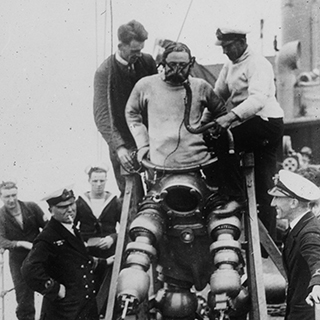The first underwater welds left much to be desired, of course, but scientists recorded the results in two historic articles:
- Strains in the End Lap Welds by P.F. Papkovich (1933)
- Design of Electric-Welded Seams for Combined Strength by Yu.A. Shimanskiy (1936)
Application in WWII
Just several years after Khrenov’s successful wet weld, the Soviets began to use the technology for their vessels, harbors and docks. With the onset of WWII, many metals were in short supply and nothing could be wasted. In 1936, crews performed underwater welding as part of the effort to lift an enormous ship called Boris out of the Black Sea.
With success under the water, Khrenov didn’t stop there. He devoted most of his life research to welding, and he improved upon several technologies:
- Electrode Coatings
- Resistance-welder Power Supplies
- Ceramic Fluxes
Khrenov also found ways to enhance gas-pressure welding, plasma-arc cutting and cold welding. Beyond his research and new welding technology developments, he also taught at three other universities besides ETU.
Carrying the Wet Welding Torch: Cyril D. Jensen

In America during the early and mid 1940’s, Cyril Jensen began his own underwater welding testing. Fascinated with Khrenov’s work, Jensen sought to start an underwater welding program in the US.
With a master’s degree from LeHigh University, Jensen went on to earn his civil engineering degree from Minnesota in 1931. Shortly thereafter, Jensen started teaching at LeHigh. However with the US brought into WWII, he received a leave of absence in 1942 and traveled to the Annapolis naval engineering experiment station for welding research.
For the years that followed in the war, Jensen served in the Navy and conducted the operations for their underwater welding and cutting program. Some of his most notable underwater construction includes salvaging several of the sunken ships in Pearl Harbor.
After WWII ended, Jensen went back to LeHigh to teach. He served as the president of the American Welding Society for the LeHigh Valley chapter.
During the his life, Jensen vastly expanded the underwater welding program in the US and helped create the arc-oxygen underwater cutting process. He holds two underwater welding patents and wrote (or co-wrote) 18 research papers on the topic.


